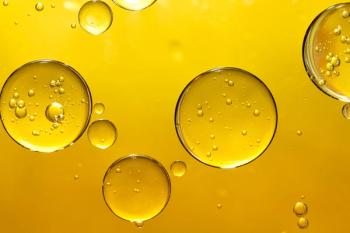
At HTC-18 in Leuven, Executive Editor of LCGC International, Alasdair Matheson, spoke to Chiara Cordero from the University of Turin about the evolving role of AI and its effect on GCxGC in foodomics.


At HTC-18 in Leuven, Executive Editor of LCGC International, Alasdair Matheson, spoke to Chiara Cordero from the University of Turin about the evolving role of AI and its effect on GCxGC in foodomics.

Scientists from the University of Turin, Italy have learned how to combine their complementary competencies in analytical chemistry and big data analytics to achieve significant advances in food science and health.

Here are the top five articles that the editors of LCGC International published this week.

Scientists recently analyzed the chromatographic profiles of postmortem bacterial species and their volatile organic compounds (VOCs) using comprehensive two-dimensional gas chromatography (GCxGC).

Kate Perrault Uptmor is an assistant professor at William & Mary focusing on nontargeted analysis on highly complex samples.

During the 18th International Symposium on Hyphenated Techniques in Chromatography and Separation Technology, experts presented a workshop on emerging industrial applications in MS.

In this edition of The LCGC Blog, Katelynn Perrault and James Harynuk discuss the technological needs one faces when setting up a workstation for chromatography data analysis.

At the 2024 Pittcon Conference, Elizabeth Humston-Fulmer of LECO Corporation presented an improved workflow which uses two-dimensional gas chromatography (GCxGC) with dual time of flight (TOF) MS/FID detection. Shortly after Pittcon, Humston-Fulmer discussed this analytical method with us.

In this edition of “Inside the Laboratory,” Katelynn Perrault Uptmor, PhD, an assistant professor of chemistry at the College of William and Mary, discusses her group’s current research endeavors, including using complex comparative data obtained from chemical analysis to understand and solve challenges in forensic science and other life science applications.

This study explores the feasibility of using human skin volatile organic compounds (VOCs) analyzed through comprehensive gas chromatography–time of flight–mass spectrometry (GCxGC-TOF-MS) and chemometric techniques, to potentially serve as biomarkers for tuberculosis diagnosis.

A recent review article examines how solid-phase microextraction–comprehensive multidimensional gas chromatography (SPME-GC×GC) has contributed to food analysis over the past 20+ years.

During a workshop at Pittcon, David Alonso of LECO Corporation discussed how gas chromatography–time-of-flight mass spectrometry (GC-TOFMS) can be used to identify polyfluorinated alkyl chemicals (PFAS) chemicals in anti-fog product solutions.

The 18th International Symposium on Hyphenated Techniques in Chromatography and Separation Technology will take place from 28–31 May 2024 in Leuven, Belgium.

Blood and sputum are the most common means of detection by diagnostic tests, but producing adequate sputum can be difficult given a dry cough is often a TB symptom.

The 15th Multidimensional Chromatography Workshop is a free event involving keynote and contributed presentations, a poster session, and discussion groups on all multidimensional techniques, and will be held in-person on the campus of California State University, Los Angeles, from January 10 to 12, 2024.

LCGC spoke to Leandro Wang Hantao from the University of Campinas in São Paulo, Brazil, about his work investigating the influence of ion management parameters on the data produced by comprehensive gas chromatography–high-resolution mass spectrometry (GC×GC–HRMS) equipped with a fourier transform-orbital ion trap mass analyzer, and his investigation into employing channel occlusion for sample preparation in untargeted analysis in petroleomics.

Are you interested in ChatGPT's vast potential? Or are you getting tired of reading or hearing about ChatGPT?

Scott Fenwick, technical director of Clean Fuels Alliance America, was the keynote speaker at the Gulf Coast Conference in Galveston, Texas, where he held a lecture on the growth of biomass-based fuels.

This article demonstrates how sorptive extraction is a highly efficient technique for the VOC profiling of honey samples.

The 27th International Symposium on Separation Sciences (ISSS 2023) will be held 24–27 September 2023 in Cluj-Napoca, Romania. Here’s a sneak preview of what attendees can look forwards to.

Comprehensive two-dimensional GC×GC has made great strides in the past 20 years. The author discusses advances in instrumentation, column sets, data analysis, and the range and types of samples amenable to this method.

Recent developments in GC×GC that make it more amenable for routine use are discussed.

As part of the upcoming Recent Advances in Gas Chromatography meeting, Nicholas Morley will look at how two-dimensional gas chromatography-time-of-flight-mass spectrometry analyzes pharmaceutical packaging.

Two-dimensional gas chromatography time-of-flight mass spectrometry (GCxGC/TOF-MS) and gas chromatography–time-of-flight mass spectrometry (GC-TOF-MS), two different gas chromatography techniques, will have their procedures and uses compared at the Science and Industry Museum, in Manchester, UK.

There are several key benefits to using multidimensional GC techniques in routine analysis. An examination of mineral oil analysis in food reveals the utility of these techniques.